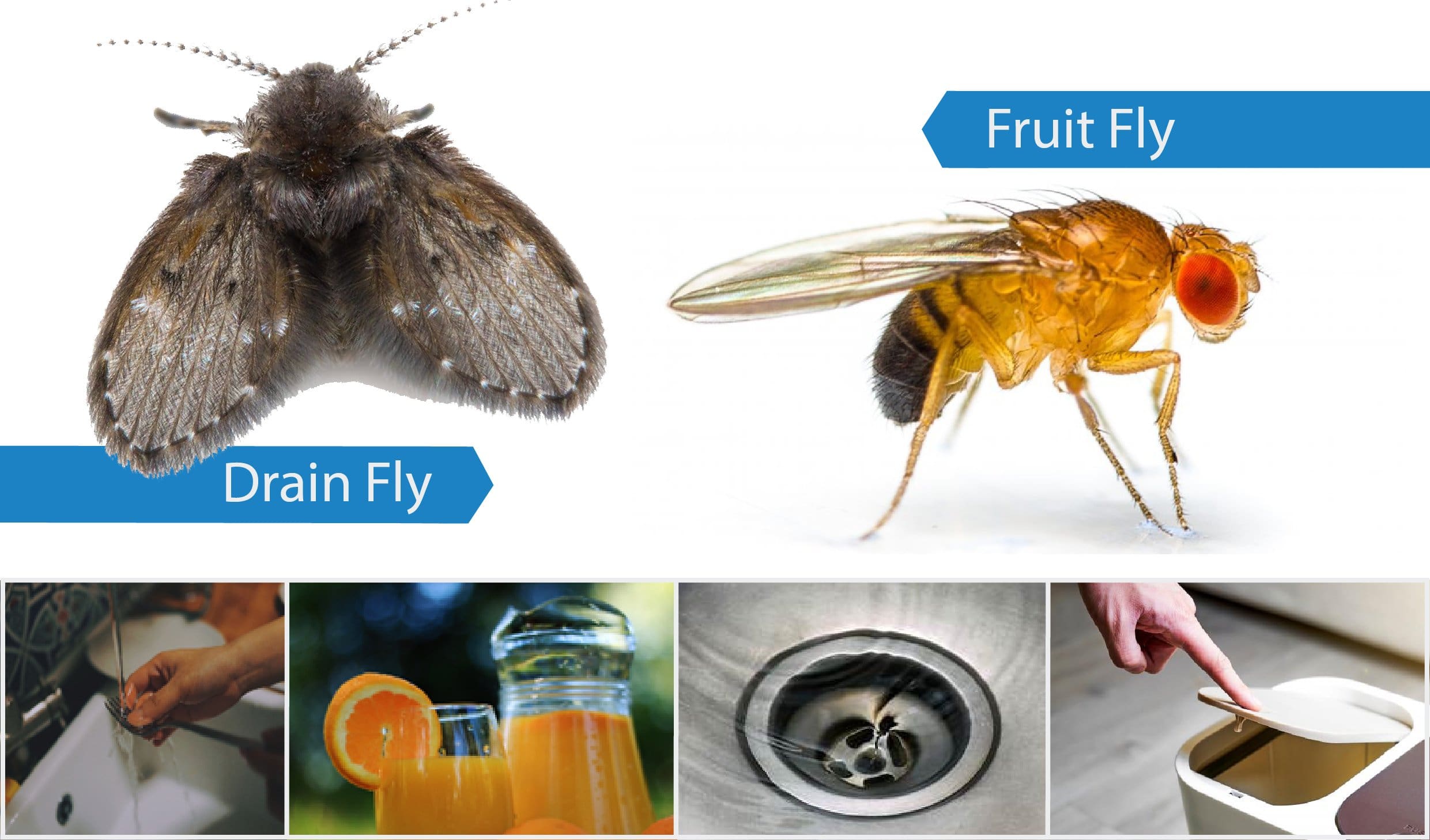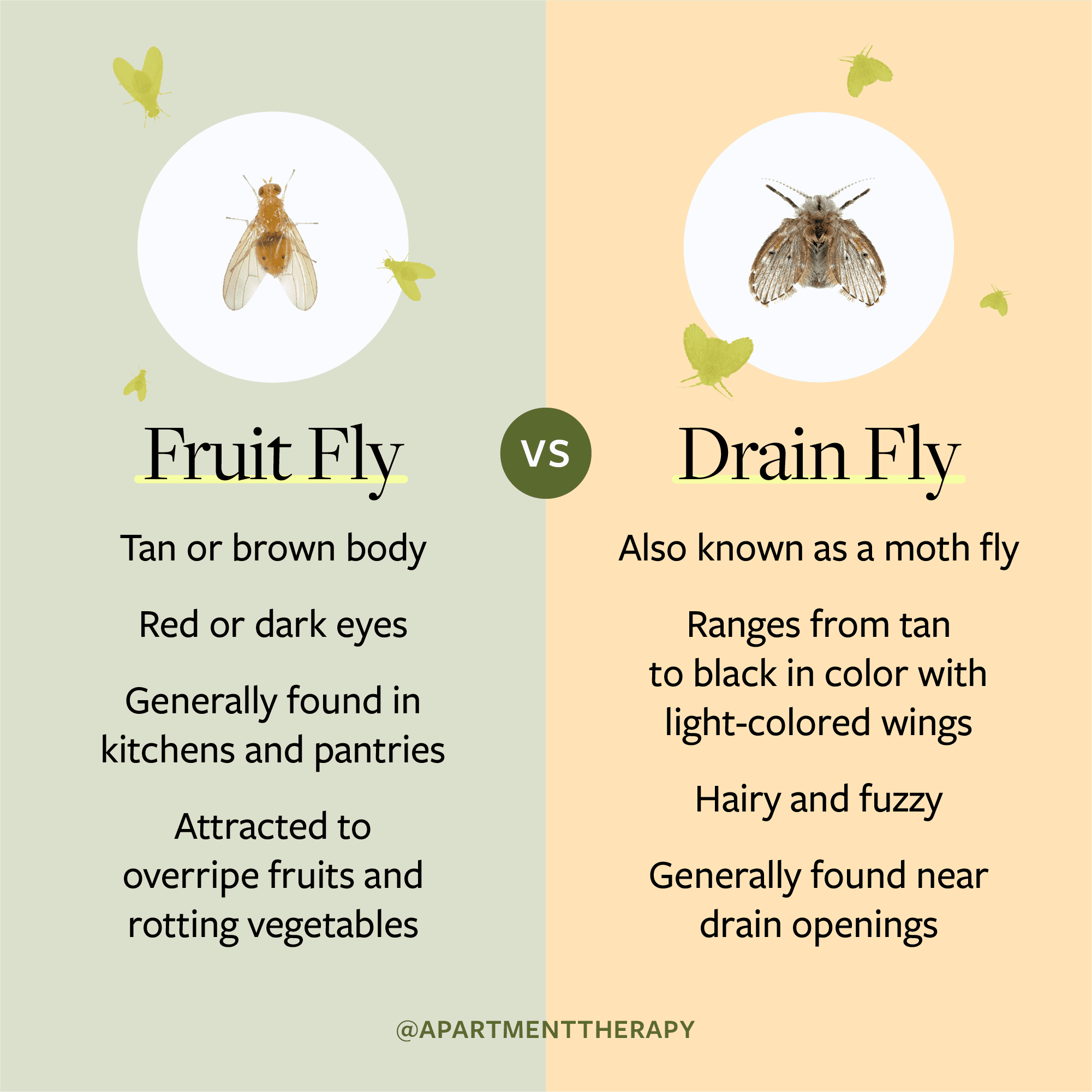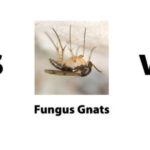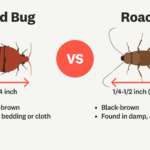Imagine you’re enjoying a peaceful evening at home, and suddenly, tiny flies start buzzing around your kitchen. Annoying, right?
You might think they’re all the same, but they could be either fruit flies or drain flies. Both are small, but their origins and habits differ vastly. So, how can you tell which one has invaded your space? And more importantly, how can you get rid of them for good?
We’ll dive into the world of fruit flies versus drain flies, helping you identify and tackle your tiny intruders with ease. Keep reading to discover how to reclaim your home from these pesky invaders and restore your peaceful haven.
Identifying Fruit Flies
Identifying fruit flies can be a bit tricky. They are tiny insects often found buzzing around your kitchen. Knowing their characteristics helps in distinguishing them from other pests. Let’s dive into their physical traits, habitats, and behaviors.
Physical Characteristics
Fruit flies are small, measuring about 1/8 inch in length. Their bodies are tan or light brown. You might notice their distinct red eyes. These features make them easy to spot. Their wings are clear and slightly rounded.
Common Habitats
Fruit flies thrive in warm, moist environments. They love rotting fruits and vegetables. You’ll find them near garbage bins. They also gather around drains and uncleaned spills. Any place with fermenting food attracts them.
Behavior Patterns
Fruit flies are known for rapid reproduction. A single female lays hundreds of eggs. Their life cycle completes in about a week. They hover around food sources constantly. Their presence is often a sign of decaying matter nearby.
Identifying Drain Flies
Have you ever noticed tiny flies buzzing around your kitchen or bathroom and wondered what they are? Identifying drain flies can be crucial in tackling the pest problem effectively. These little insects can be quite a nuisance, but understanding their physical characteristics, common habitats, and behavior patterns can help you deal with them confidently.
Physical Characteristics
Drain flies, also known as sewer flies or moth flies, are small, usually measuring about 1/8 inch in length. Their bodies are fuzzy and covered with hair, giving them a moth-like appearance. They are typically gray or tan, and their wings form a roof-like shape over their bodies when at rest. Have you ever mistaken them for fruit flies? The key is in their wings; drain flies have unique vein patterns that set them apart.
Common Habitats
These pesky flies thrive in moist environments. You’ll often find them near drains, hence the name, but they also reside in other places like sewage treatment plants and damp basements. Have you noticed them around your shower or kitchen sink? They love areas where organic matter accumulates and decay. Their presence usually indicates a buildup of gunk or debris, something you can clean to discourage them.
Behavior Patterns
Drain flies are not strong fliers. They tend to hover around drains or rest on walls near water sources. Their life cycle is short, but they reproduce quickly, laying eggs on the gelatinous film in drains. Have you tried to swat them away, only to see them return? They are persistent but not aggressive, posing no health risks directly. However, their rapid multiplication can be quite annoying.
Are you dealing with a drain fly infestation right now? Identifying these aspects can be your first step in addressing the problem. Understanding their habits gives you the upper hand. Have you considered regular drain cleaning to keep them at bay? Share your experiences in the comments below!
Differences Between Fruit Flies And Drain Flies
Have you ever found yourself battling tiny invaders in your kitchen or bathroom? It could be fruit flies or drain flies, and while they might seem similar, they have distinct characteristics. Understanding these differences can help you tackle them more effectively. Let’s dive into the world of these pesky critters and learn how to differentiate between fruit flies and drain flies.
Visual Differences
Fruit flies are small, usually around 1/8 inch long. They have a tan or brownish body with distinctive red eyes. If you’ve seen them buzzing around your fruit bowl, you’ve likely noticed their rapid flight pattern.
Drain flies, on the other hand, are slightly larger, resembling tiny moths. They’re typically gray or brown with fuzzy wings. Their flight is slower and more erratic. Next time you’re near a sink or drain, take a closer look and see if you can spot them.
Breeding Habits
Fruit flies lay their eggs on the surface of rotting fruit or fermenting materials. Their lifecycle is quick, making them a challenge to control if you don’t act fast.
Drain flies prefer to lay their eggs in moist environments, particularly in organic matter found in drains. Their larvae thrive in the slimy buildup within pipes. Have you checked your drains recently?
Preferred Environments
Fruit flies love warm, moist areas with easy access to food. Kitchens with exposed fruit and vegetables are their favorite spots. Keeping these areas clean can significantly reduce their presence.
Drain flies, as their name suggests, favor drains, sewage systems, and anywhere with stagnant water. Bathrooms and laundry rooms are common breeding grounds. Regular maintenance and cleaning can keep them at bay.
Understanding these differences not only helps in identification but also in prevention and control. Have you ever mistaken one for the other? Knowing your enemy is half the battle in keeping your home fly-free!

Credit: trashcansunlimited.com
Preventing Fruit Flies
Distinguishing fruit flies from drain flies is essential for effective prevention. Fruit flies thrive near ripe produce, while drain flies breed in stagnant water. Keeping kitchens clean and disposing of food waste promptly can deter fruit flies, whereas addressing plumbing issues helps combat drain flies.
Preventing fruit flies in your home can feel like an endless battle. These pesky invaders seem to materialize out of nowhere, especially when your kitchen is filled with ripe fruits or leftovers. Understanding how to keep them at bay not only saves your sanity but also keeps your kitchen fresh and clean. Let’s dive into the essentials of fruit fly prevention.Kitchen Hygiene Tips
Maintaining a clean kitchen is your first line of defense against fruit flies. Regularly wipe down countertops and dining tables to remove any food residue. Make sure you wash your dishes promptly after meals. This simple habit can significantly reduce your chances of attracting fruit flies. Empty your trash cans often. Fruit flies are attracted to decaying food, so keeping garbage bins clean and covered is crucial. Consider using trash bags that seal tightly to prevent any smells from escaping.Proper Food Storage
Storing your food correctly can make a huge difference. Keep fruits and vegetables in the refrigerator whenever possible. This not only extends their shelf life but also deters fruit flies. If refrigeration isn’t an option, store fruits in airtight containers. You might find that glass jars work best, as they provide a tight seal and allow you to see what’s inside easily. Avoid leaving ripe fruits on countertops. They are like a beacon for fruit flies, inviting them into your home.Natural Deterrents
Natural deterrents can be a game-changer for keeping fruit flies away. Apple cider vinegar traps are an easy and effective solution. Simply pour some vinegar into a bowl, cover it with plastic wrap, and poke small holes in the wrap. Fruit flies are drawn to the vinegar but can’t escape once inside. Consider using essential oils like peppermint or lemongrass. Their strong scents can repel fruit flies. Dab a few drops on cotton balls and place them around your kitchen. Do these strategies resonate with your current kitchen routine? Implementing them can transform your space into a fruit fly-free zone. Are there any other home remedies you’ve tried that worked wonders?Preventing Drain Flies
Fruit flies and drain flies often get confused, but prevention methods vary. Drain flies thrive in moist environments, often found near sinks and drains. Regular cleaning of drains can help prevent their infestation, while fruit flies are attracted to ripe fruits, requiring different measures like proper food storage.
Preventing drain flies can save you from the nuisance and hygiene issues they bring. These tiny pests love damp environments, making your kitchen and bathroom drains their favorite spots. But with a few preventive measures, you can keep them away for good.Regular Drain Cleaning
Keep your drains clean to deter drain flies. A simple mix of baking soda and vinegar works wonders. Pour half a cup of baking soda followed by a cup of vinegar down the drain. Let it fizz for a few minutes, then rinse with hot water. This method not only clears clogs but also eliminates the gunk that attracts flies. I learned this trick when I noticed a sudden swarm of flies in my kitchen. After trying it, they disappeared within days. Have you ever tried cleaning your drains this way?Moisture Control
Drain flies thrive in damp areas, so controlling moisture is key. Fix any leaks under sinks promptly. Use a dehumidifier in damp bathrooms to keep moisture levels low. I once ignored a tiny leak under my bathroom sink, and the flies quickly multiplied. A small repair and a dehumidifier later, the problem was solved. Are there any leaks in your home that need attention?Use Of Drain Covers
Drain covers can be your first line of defense against drain flies. They prevent flies from entering drains and laying eggs. Choose covers with small holes to ensure they effectively block these pests. I started using drain covers after battling a persistent fly problem. It was like closing the door to an unwanted guest. Have you considered adding drain covers to your home? They might just be the shield you need. Engaging in these small practices can make a big difference in keeping drain flies at bay. What steps will you take today to keep your home fly-free?Eliminating Fruit Flies
Fruit flies and drain flies often infest homes, but they thrive in different environments. Fruit flies are attracted to ripe fruits and vegetables, while drain flies breed in sink drains and sewage areas. Eliminating them involves targeting their breeding grounds effectively.
Eliminating fruit flies can be a challenging task. These tiny invaders multiply rapidly, making your kitchen their playground. They thrive on ripe fruits, vegetables, and even garbage. To keep them at bay, you’ll need a mix of effective strategies. From simple homemade traps to commercial solutions, there are ways to tackle this issue. Long-term strategies can also ensure they don’t return. Let’s explore some practical methods to eliminate fruit flies.Homemade Traps
Homemade traps are an easy way to catch fruit flies. Use items already in your kitchen. A simple trap can be made with apple cider vinegar. Pour some into a bowl. Cover it with plastic wrap and poke small holes. Flies will get trapped inside. Another method is using a paper cone. Place it over a jar with fruit scraps. Flies enter but can’t escape. These traps are both cheap and effective.Commercial Solutions
There are many commercial solutions available for fruit flies. Sticky traps are a popular choice. Hang them near fruit bowls or trash cans. They attract and catch flies quickly. Consider using insect sprays too. Some sprays target fruit flies specifically. Always follow instructions on the label. Ensure the area is safe for food afterward.Long-term Strategies
For lasting results, focus on prevention. Keep your kitchen clean and tidy. Store ripe fruits in the fridge. Empty garbage bins daily. Clean drains regularly as well. Use a mixture of baking soda and vinegar. This keeps drains fly-free. Seal all open food containers. This prevents flies from breeding. With these strategies, you can enjoy a fly-free home.Eliminating Drain Flies
Drain flies can be a nuisance in any home. These tiny pests breed in moist areas. They often infest sinks, showers, and drains. To get rid of them, you need a strategic plan. This involves cleaning, maintenance, and sometimes professional help.
Cleaning Solutions
Start by cleaning your drains thoroughly. Use a stiff brush to scrub the inside of the pipes. Remove any debris or build-up. Pour a mixture of baking soda and vinegar down the drain. Let it sit for 15 minutes. This solution helps to break down organic matter. Rinse the drain with boiling water to clear the residue.
Plumbing Maintenance
Regular plumbing checks can prevent infestations. Ensure there are no leaks or standing water. Fix any plumbing issues promptly. Standing water provides a breeding ground for drain flies. Check for clogs and clear them immediately. Use a plunger or a plumber’s snake for stubborn clogs.
Professional Pest Control
If the infestation is severe, consider professional help. Pest control experts have the tools to eliminate drain flies. They use safe and effective treatments. Professionals can also offer advice on preventing future infestations. It’s an investment in a pest-free home.

Credit: pestcontrolservices.co.uk
When To Seek Professional Help
Persistent infestations of fruit flies and drain flies can be frustrating. Consider seeking professional help when DIY methods fail. Experts can identify and eliminate the source effectively, ensuring a fly-free environment.
When dealing with fruit flies or drain flies, sometimes DIY methods aren’t enough. Persistent fly problems can affect your home’s comfort and hygiene. Knowing when to call professionals can save time and stress. Here’s how to recognize severe infestations and choose the right help.Signs Of Severe Infestation
Large numbers of flies indicate a severe infestation. You may notice them in multiple rooms. This means they breed rapidly. Another sign is persistent foul odors. Drain flies often cause this near sinks or drains. Fruit flies might linger near trash or fruit bowls. DIY solutions don’t work for long-lasting infestations. Professional help becomes necessary.Choosing A Pest Control Service
Look for pest control services with good reviews. Experience matters in handling infestations. Check if they offer free inspections. This helps in assessing the problem properly. Ensure they use eco-friendly methods. This is important for safety and effectiveness. Compare quotes from different services. It helps in finding a reasonable price. Choose a service that offers a guarantee. This ensures satisfaction and peace of mind.
Credit: www.apartmenttherapy.com
Frequently Asked Questions
What Are Fruit Flies And Drain Flies?
Fruit flies are small, tan insects. Drain flies are gray, moth-like bugs. Both are nuisances in homes.
How Can I Identify Fruit Flies?
Fruit flies have red eyes and tan bodies. They are attracted to ripe fruits. Easy to spot.
Where Do Drain Flies Come From?
Drain flies breed in moist areas. They thrive in drains and sewage. Often found near sinks.
Are Fruit Flies Harmful To Health?
Fruit flies don’t bite. But they can spread germs. They are annoying, not dangerous.
How To Eliminate Drain Flies Effectively?
Clean drains thoroughly. Use vinegar and baking soda. Keep areas dry to prevent breeding.
Conclusion
Distinguishing between fruit flies and drain flies is essential. Both pests can invade homes. Fruit flies are attracted to ripe produce. Drain flies prefer moist, decaying matter. Recognizing their differences helps in effective control. Keep kitchens clean to deter fruit flies.
Regularly clean drains to avoid drain flies. Simple habits can prevent infestations. Use traps if needed for both types. Identifying these tiny invaders is key. Protect your home from unwanted pests. Stay vigilant and maintain cleanliness. Enjoy a pest-free environment at home.
Small efforts can make a big difference. Your home deserves to be fly-free.




